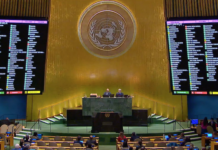
OPINION: By Dr Shailendra Singh
Climate change seems to be getting increasingly more news coverage recently, which is a positive outcome—on at least some levels.
But how engaging is the material?
A core challenge with climate-change reporting is not only generating sufficient public interest, but sustaining it.
This is partly because climate change used to lack the immediacy of hard news—the here and now effect—although this is changing, as the damaging effects of the phenomenon become more apparent.
Many local Pacific climate change news stories seem to rely on speeches and press statements.
Yes, journalists can fill news holes quite easily in this manner to meet deadline imperatives.
But is this style and nature of reporting really capturing people’s attention, assuming that is the goal?
For example, the speeches of many Pacific Island leaders receive widespread coverage.
Such speeches are usually targeted at fellow world leaders, which is quite necessary and legitimate in some respects.
Lavish coverage
Other news stories are usually based on international meetings and conferences. They receive lavish coverage. These are big and important stages, and they should get fair representation.
But to what extent are local audiences connecting with these stories? That’s assuming that local audiences matter in climate change.
How relevant and compelling are the speeches and press statements to local ears? Is the oratory having any impact, or starting to sound bland and repetitive? This is something worth considering if the idea is to inform people and mobilise them into action.
Once, we used to complain about the scarcity of coverage. However, slanted and saturated coverage of a certain type is also problematic in its own way.
The point I’m making is that the media’s challenge is to make stories interesting and relevant; otherwise readers, listeners and viewers may simply switch off.
Capturing and holding audience attention will require more than just republishing statements and speeches ad nauseam.
The gratuitous coverage given to presidents, prime ministers, diplomats, heads of regional organisations and other bureaucrats needs to be balanced with coverage of grassroots people who are actually experiencing the effects of climate change first-hand.
Compelling stories
This would make the stories more compelling, and the problem appear more real, rather than far-removed and abstract.
Why not cover more human interest stories, rather than bore readers to death with statistics, speeches and scientific jargon only?
If the speeches have to be used, at least derive some original ideas from them; for example, the blame game is rife with developed world leaders accused of inaction, and rightly so.
But are Pacific Island leaders walking the talk or not? Have we examined this issue sufficiently enough, or are we just content with speech making? For example, mangroves are one of the best protection against sea level rise.
Yet there are reports of mangrove destruction, even in the face of big international meetings.
Large tracts have reportedly been cleared in Lami, Wailekutu, Nasese, Vatuwaqa and elsewhere, for the sake of industrial development, tourism projects and urbanisation.
Professor Wadan Narsey, Dr Ajantha Perer and others have written about this.
National Green Strategy
How does this trend figure in our national Green Sustainable Growth Strategy?
Does it contradict the grand sounding speeches at major international meetings?
Also, does Fiji have a national mangrove replanting scheme? Who would finance any such undertaking?
How much is allocated to such projects compared to meetings and conferences?
Are grassroots projects sufficiently funded or is the money gobbled up by professional junketeers?
Some time back there was a moratorium on mangrove destruction. But why not a total ban, as in many other countries?
My point is, instead of just reporting speeches and statements, we need to conduct our own research independently. We need to formulate the hard questions and seek answers from leaders; otherwise there is a risk of getting too caught up in the hype of big meetings and high-profile speakers.
Yes, such meetings are important for various reasons, including crucial and binding international treaties. The meetings attract some very learned people who know their stuff.
Pacific leaders have vital roles at such meetings, and they have achieved some outstanding results.
Fair and balanced
Still, the coverage should be fair and balanced, rather than skewed and elitist.
Reporters should not lose touch with the realities on the ground or the fundamentals of journalism—to be skeptical and question things, rather than rely on handouts alone.
The job remains the same—keep governments and leaders accountable, rather than cut-paste speeches.
In journalism, single sources are risky and inadequate, so also cite the work of other researchers and commentators, for the sake of balance—which is a requirement under the 2010 Media Industry Development Decree anyway!
Use the information to derive questions and grill leaders; otherwise there is a risk that the coverage will become merely a PR exercise, which would be both wasteful and counterproductive.
The idea is to make climate change and its effects relevant locally to help comprehend and develop a proper consciousness of the problem on a global level—a problem which the scientific community describes as lethal for earth and its inhabitants.
Dr Shailendra Singh is a senior lecturer and coordinator of the University of the South Pacific Journalism Programme. This article is based on a presentation by the writer at a special briefing for journalists on climate change on 18 September 2017 at USP.
- Timely climate media strategy to empower citizens – Pacific Journalism Review











































